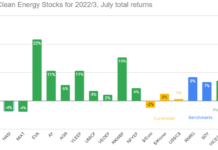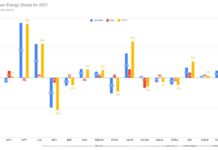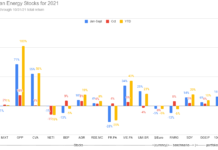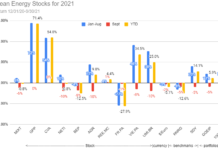Tom Konrad, CFA
Three months have passed since I published my annual clean energy mini-portfolio. So far, these stocks have beaten the Powershares Wilderhill Clean Energy Index (PBW) handily, but they trail the broader market.
This is the third year in a row I’ve published a list of ten stocks for the year ahead at the end of December. In 2008 my list trailed the broader stock market but beat the clean energy index, and last year it outperformed both. So far, this year looks more like 2008 than 2009. In addition to the portfolio of ten stocks, I gave an alternative portfolio which substituted two specialized exchange traded funds for six of the stocks. You can read the original article here.
For the first quarter, the portfolio was up 1.3%, including dividends, and the alternative portfolio with 4 stocks and two exchange traded funds (ETFs) was down 1.2% with dividends. These two results were bracketed by the broad Russell 3000 index (up 4.03%) and my sector benchmark, the Powershares Wilderhill Clean Energy ETF (PBW), which was down 11.57%.

Individually, here is how the stocks have performed:
Electric Grid Stocks
General Cable (BGC): Down 14.8%. The company fell on lowered earnings guidance on February 11. I took an in-depth look at General Cable’s prospects shortly thereafter.
MasTec (MTZ): Up 0.4%.
C&D Technologies (CHP): Up 12.2%.
Collectively, these three stocks were down 0.7%, which beat the substitute ETF, the Smart Grid Infrastructure Index Fund (GRID), which was down 5.5%
Efficient Transportation Stocks
New Flyer Industries (NFI-UN.TO, NFYIF.PK): up 16.0%
Firstgroup PLC (FGP.L): down 15.5%
Portec Rail Products (PRPX): up 14.2%. Portec is the subject of a cash takeover by L. B. Foster Company (FSTR). If the merger goes through, I plan to look for a replacement.
Collectively, my transport picks are up 4.9%, compared to a 1.1% gain for the substitute ETF, the Powershares Global Progressive Transport ETF (PTRP.)
Energy Efficiency Stocks
Waterfurnace, Inc. (WFI.TO, WFIFF.PK): up 9.5%
Linear Technology Corp (LLTC): down 8.4%
Flir Systems, Inc. (FLIR): down 13.4%
Collectively, my energy efficiency picks were down 0.7%. There is no efficiency ETF with which to compare them.
Biomass Stock
Waste Management (WM): up 2.9%.
Conclusion
The biggest surprises of the quarter were the relative poor performance of the clean energy ETFs, PBW, GRID, and PTRP. I’ve long thought that stock picking can be useful in clean energy because it is a new, rapidly changing sector that is not yet closely followed by many Wall Street analysts. Three months of outperfomance compared to these exchange traded index funds means very little. But now that we have over two years of outperfomance relative to the clean energy ETFs, it is starting to look like a trend.
This year was the first year the sub-sector ETFs GRID and PTRP were available, and they allow us to dissect the portfolio’s performance in more detail. In general, I think the broad clean energy ETFs such as PBW over-emphasize popular sectors such as solar, and under-emphasize less exciting sectors such as efficiency. GRID and PTRP underperformed my corresponding picks by about four percent each, but the broad clean energy ETF underperformed my picks by about 13%. Assuming my outperformance was not luck, we can attribute 9% of it to the emphasis on Energy Efficiency, Electric Grid, and Clean Transportation sectors over Solar and Wind. The other 4% outperformance would be from old fashioned stock picking within sectors.
Even successful stock picking is not likely to lead to profits when the market as a whole is down, as we saw in 2008. My picks that year only looked good in comparison to PBW. I continue to expect a general market decline in 2010, and so I continue to wait before I commit much money to any of these picks. When I do, I’ll let you know.
DISCLOSURE: Long BGC, CHP, NFYIF, PRPX, WFIFF, and WM.
DISCLAIMER: The information and trades provided here are for informational purposes only and are not a solicitation to buy or sell any of these securities. Investing involves substantial risk and you should evaluate your own risk levels before you make any investment. Past results are not an indication of future performance. Please take the time to read the full disclaimer here.







